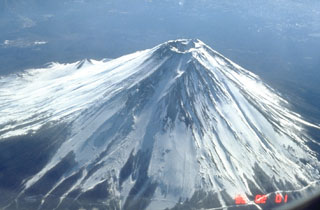Report on Fujisan (Japan) — August 1987
Scientific Event Alert Network Bulletin, vol. 12, no. 8 (August 1987)
Managing Editor: Lindsay McClelland.
Fujisan (Japan) Earthquake swarm below summit probably tectonic
Please cite this report as:
Global Volcanism Program, 1987. Report on Fujisan (Japan) (McClelland, L., ed.). Scientific Event Alert Network Bulletin, 12:8. Smithsonian Institution. https://doi.org/10.5479/si.GVP.SEAN198708-283030
Fujisan
Japan
35.361°N, 138.728°E; summit elev. 3776 m
All times are local (unless otherwise noted)
About nine small earthquakes of M < 2 occurred beneath the summit 20 August-1 September. Four were felt at intensities of I-III (JMA scale) by personnel at the summit meteorological observatory, but were not felt at the weather station 19 km ESE of the summit. Seismographs confirmed that the earthquakes originated just underneath the summit. JMA installed a portable seismograph at the summit on 25 August. The strongest earthquake, on 20 August at 0556, had a magnitude of 1.8 (table 1). No signs of wall collapse or landslides were observed by a field survey group around the summit that day. Earthquakes on 20 and 24 August were recorded by the Univ of Tokyo's Earthquake Research Institute seismographs within 20 km of the summit.
Table 1. Earthquakes at Mt. Fuji, 20 August-1 September 1987.
| Date | Time | Magnitude | Notes |
| 20 Aug 1987 | 0556 | 1.8 | felt at summit |
| 23 Aug 1987 | approx. 0100 | not recorded | felt at summit |
| 24 Aug 1987 | 0630 | 1.4 | felt at summit |
| 27 Aug 1987 | 0624 | less than 1 | -- |
| 27 Aug 1987 | 0626 | less than 1 | felt at summit |
| 28 Aug 1987 | 1355 | less than 1 | -- |
| 29 Aug 1987 | 1951 | less than 1 | -- |
| 01 Sep 1987 | 2335 | less than 1 | -- |
Small earthquakes are not rare at Fuji, but because the earthquakes occurred in the summit region during the height of the climbing season, there was some concern among government officials. However, the relatively sharp P-wave arrivals suggest that the earthquakes were tectonic in origin.
Geological Summary. The conical form of Fujisan, Japan's highest and most noted volcano, belies its complex origin. The modern postglacial stratovolcano is constructed above a group of overlapping volcanoes, remnants of which form irregularities on Fuji's profile. Growth of the Younger Fuji volcano began with a period of voluminous lava flows from 11,000 to 8000 years before present (BP), accounting for four-fifths of the volume of the Younger Fuji volcano. Minor explosive eruptions dominated activity from 8000 to 4500 BP, with another period of major lava flows occurring from 4500 to 3000 BP. Subsequently, intermittent major explosive eruptions occurred, with subordinate lava flows and small pyroclastic flows. Summit eruptions dominated from 3000 to 2000 BP, after which flank vents were active. The extensive basaltic lava flows from the summit and some of the more than 100 flank cones and vents blocked drainages against the Tertiary Misaka Mountains on the north side of the volcano, forming the Fuji Five Lakes, popular resort destinations. The last confirmed eruption of this dominantly basaltic volcano in 1707 was Fuji's largest during historical time. It deposited ash on Edo (Tokyo) and formed a large new crater on the east flank.
Information Contacts: Yoshiaki Ida and Harry Glicken, Earthquake Research Institute, Univ of Tokyo; JMA.

